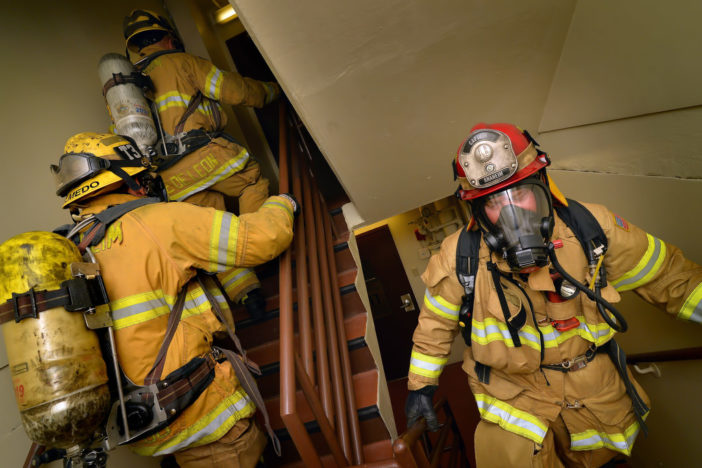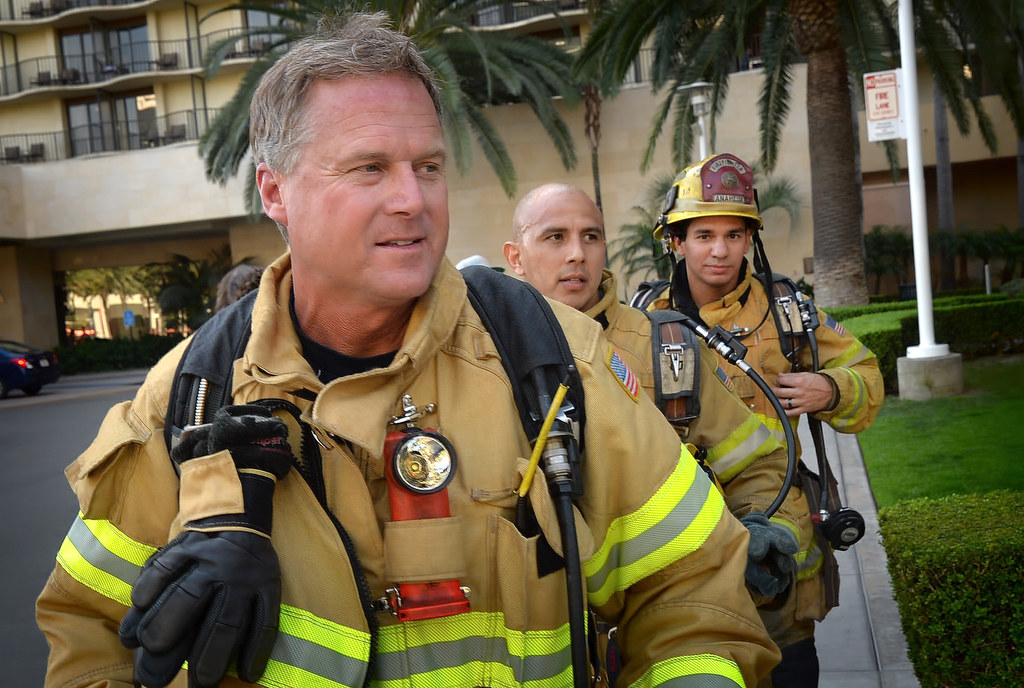You’re in the lobby of a skyscraper.
Your appointment is on the 69th floor.
The elevators aren’t working.
Even in street clothes — let alone lightweight workout garb and sneakers — the prospect of walking up all those stairs is very daunting.
Now, add 80 pounds of weight to your body.
And picture yourself wearing the equivalent of a bulky and toasty sleeping bag (full structural firefighting gear, including boots, pants, coat, helmet and gloves).

Anaheim Fire & Rescue Firefighter Paramedic Manny Ponce de Leon talks about the upcoming 25th-Annual Scott Firefighter Stairclimb in Seattle.
Photo by Steven Georges/Behind the Badge OC
And breathing in through a mask of compressed air that is delivered, in regulated amounts, from the heavy tank strapped to your back.
Oh, and one more thing:
You have to get to the 69th floor — 788 feet of vertical climbing up 1,356 steps — as quickly as possible.
That’s the (gulp) crazy-arduous task awaiting 17 members of Anaheim Fire & Rescue, who on March 6 will participate in the Scott Firefighter Stairclimb, a prestigious event in the fire service community that raises money and awareness for the Leukemia & Lymphoma Society.
Now in its 25th year, the timed climb to the observation deck of the Columbia Center in downtown Seattle last year attracted more than 1,900 firefighters from over 330 agencies, and brought in a record $2.2 million for blood-cancer research and patient services.
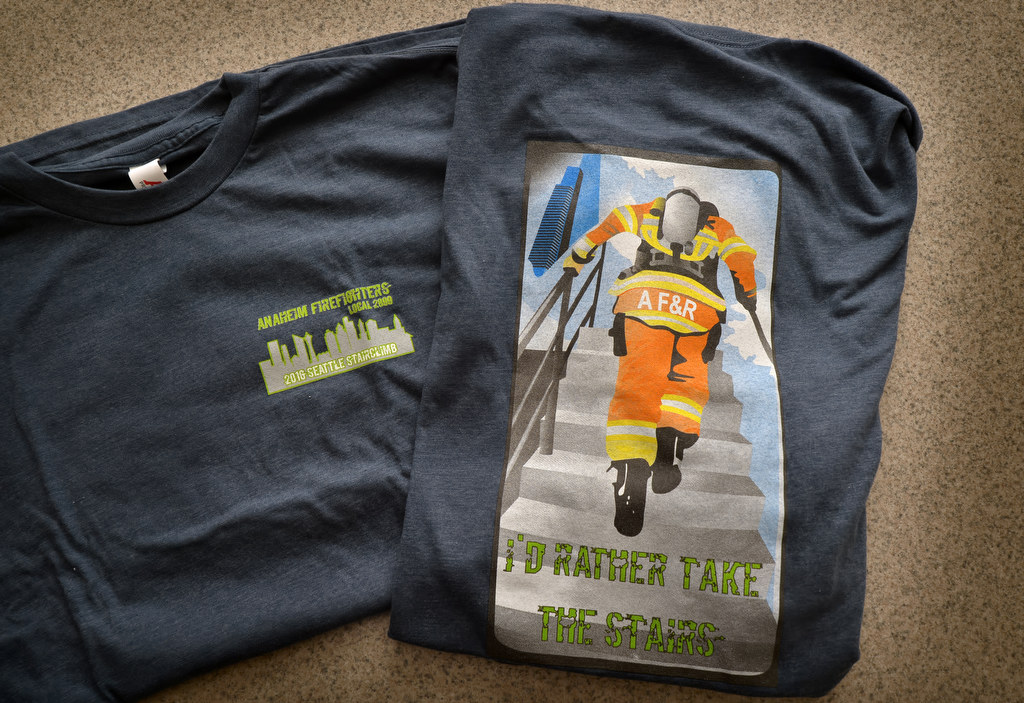
The Anaheim Fire & Rescue team shirt for the upcoming Scott Firefighter Stairclimb in Seattle that the department is selling for $20 with all the proceeds going to the Leukemia & Lymphoma Society.
Photo by Steven Georges/Behind the Badge OC
This year marks the second consecutive year that Anaheim Fire & Rescue will field a team of competitors — the only fire department from O.C. to do so.
On Friday, Feb. 12, three of the 17 AF&R competitors put on full firefighter turnout gear and wore breathing apparatus to get in a short training workout in a service stairwell of the 17-floor Anaheim Marriott.
“This is going to kick my butt,” Capt. John Strickland said of the March 6 event.
The Columbia Center, at 943 feet, is the second tallest building west of the Mississippi (behind L.A.’s 73-story U.S. Bank Tower, which is 1,018 feet).
Strickland made his remark after climbing 12 flights of the Marriott with Station 3 colleagues Manny Ponce de Leon, a firefighter paramedic, and Jericho Olmedo, a firefighter.
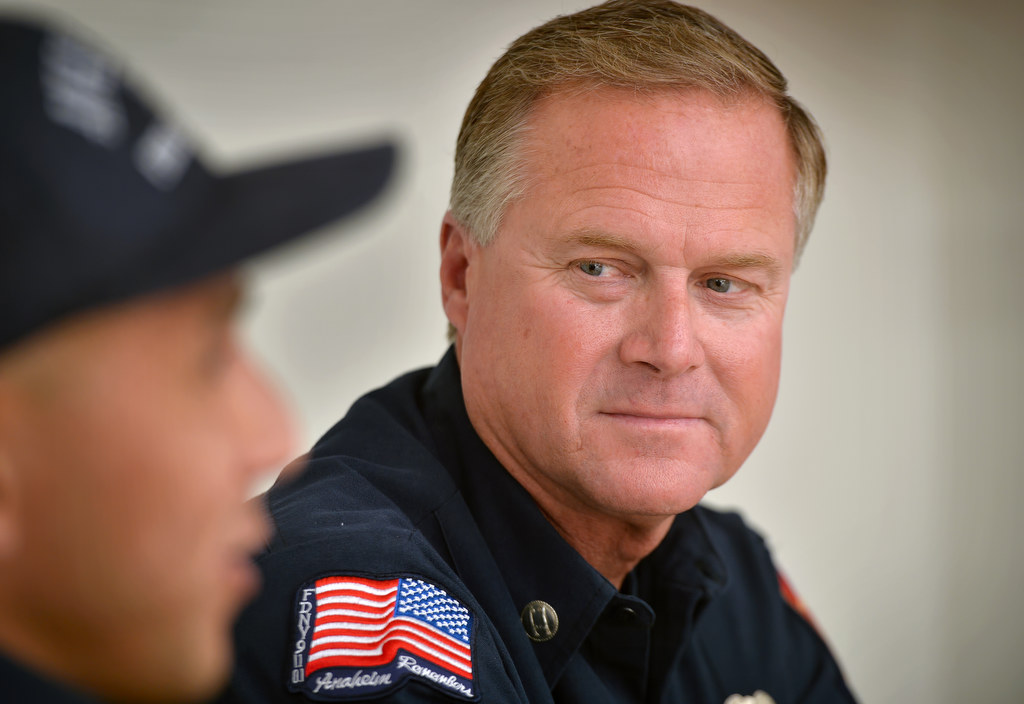
Anaheim Fire & Rescue Capt. John Strickland talks about the upcoming Scott Firefighter Stairclimb in Seattle. It will be the 53-year-old’s first time participating.
Photo by Steven Georges/Behind the Badge OC
When he took off his helmet, Ponce de Leon’s head glistened with sweat.
All three firefighters are in great shape, and all three have been training for about a month for the Scott Firefighter Stairclimb.
And all three are praying for the best.
Ponce de Leon knows what awaits.
He participated last year on AF&R’s team, and the year before as a member of the San Bernardino City Fire Department.
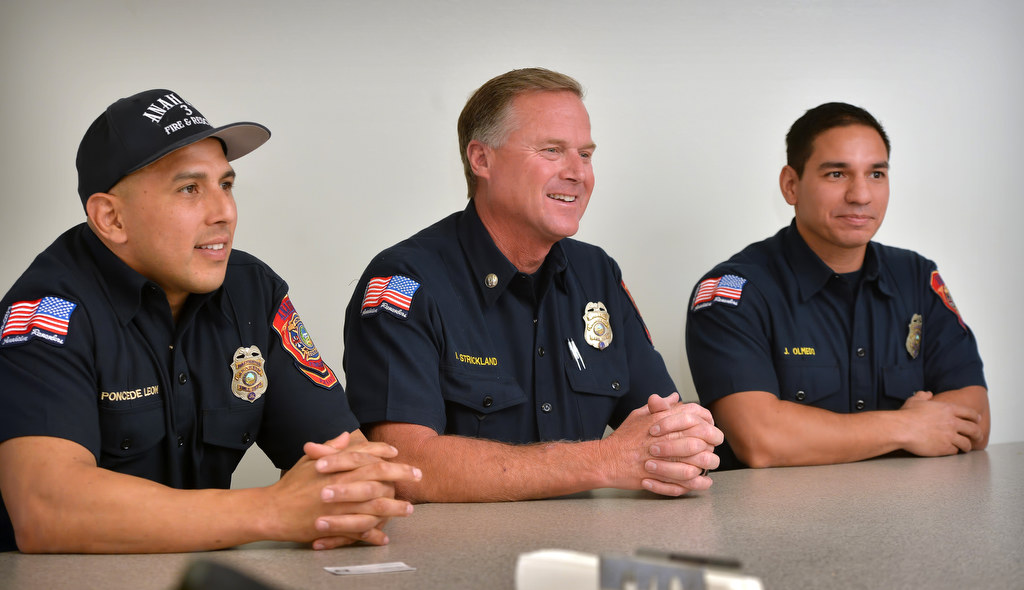
Anaheim Fire & Rescue Firefighter Paramedic Manny Ponce de Leon, left, Capt. John Strickland and Firefighter Jericho Olmedo.
Photo by Steven Georges/Behind the Badge OC
“It’s harder than a marathon,” says Ponce de Leon, captain of this year’s team (yes, he has completed marathons).
“It’s both physically and mentally very challenging.”
The average participant in the Scott Firefighter Stairclimb will finish the race within 20 and 30 minutes.
Last year’s winner, Andrew Drobeck, of Missoula City Fire (in Montana), finished in an astonishing 10 minutes and 46 seconds (he’s a 34-year-old triathlete).
The slowest climber last year finished in 2 hours and 14 minutes.
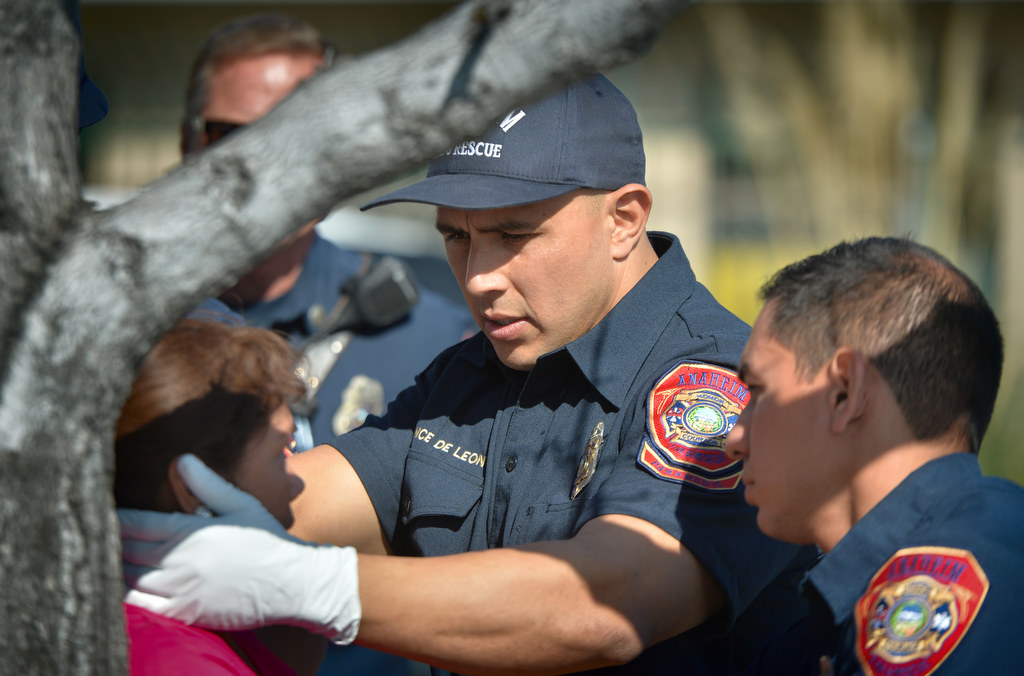
Anaheim Fire & Rescue Firefighter Paramedic Manny Ponce de Leon and Firefighter Jericho Olmedo, right, help treat a woman who was knocked down when her purse was stolen in Anaheim on Friday, Feb. 12.
Photo by Steven Georges/Behind the Badge OC
Ponce de Leon, 37, finished last year in a very respectable 22 minutes and 53 seconds. He was a tad slower than AF&R’s fastest climber last year, Mark Hernandez, who logged a lung-aching finish time of 19 minutes and 59 seconds.
At 53, Strickland is the oldest participant on AF&R’s team.
The youngest is 23.
“I’m not trying to compete — I just want to complete (it),” Strickland says of the climb.
The participating firefighters pay their own way to Seattle.
They cough up the entry fee.
They pay for their own hotel room.

Anaheim Fire & Rescue Firefighter Paramedic Manny Ponce de Leon and Firefighter Jericho Olmedo climb stairs at the Anaheim Marriott.
Photo by Steven Georges/Behind the Badge OC
And they’re required, as participants, to raise money for the Leukemia & Lymphoma Society.
For several weeks, AF&R’s team has been selling T-shirts and holding fund-raisers.
The team is just over halfway toward its goal of $5,100 (to donate, click here).
In addition to Ponce de Leon, Strickland and Olmedo, this year’s AF&R participants are Michael Eskay, Matthew Gordon, Paul Guerrero, Jason Helms, Mark Hernandez, Brad Hirst, Nolan Karns, Jeremy Keith, Luis Ledesma, Adriel Martinez, Albert Mendoza, Trent Morris, Nick Pope and Taylor Smith.
As motivation for the climbers, pictures of cancer survivors are displayed on each flight.
“It’s how I reenergize myself,” Ponce de Leon says of the photos. “You see a picture of a kid who is either a survivor or currently battling cancer. And you think, ‘OK, I am hurting, but it doesn’t compare to the pain this kid is going through or went through.’”

Anaheim Fire & Rescue Firefighter Paramedic Manny Ponce de Leon hopes to climb the 69 flights in 20 minutes or less.
Photo by Steven Georges/Behind the Badge OC
On the 40th floor, participants can switch out their air tanks for a fresh one. The tanks usually last 30 minutes, but under so much exertion, the compressed air can run out in half that time — or less.
Every 10th floor has a water station. But some firefighters don’t want to bother with taking off their breathing apparatus.
Every person on AF&R’s climbing team has some connection to someone who has had cancer, the firefighters said. Strickland mentioned Robert “Bobby” Cournoyer, an AF&R firefighter who died of leukemia in 1998 at age 35.
For now, with March 6 rapidly approaching, the 17 AF&R firefighters are focusing on three words – the slogan of the Scott Firefighter Stairclimb:
Climb. Conquer. Cure.

Anaheim Fire & Rescue Firefighter Jericho Olmedo trains for the upcoming Scott Firefighter Stairclimb in Seattle.
Photo by Steven Georges/Behind the Badge OC
To train for the 69-floor climb, Ponce de Leon has been wearing a 60-pound vest and using a revolving-step machine at a gym.
“I climb until I can’t climb anymore,” Ponce de Leon said.
The special training is very beneficial for AF&R firefighters, Strickland noted. Station 3, for example, has more than 300 hotels in its area — the majority of them with stairs.
“This coincides very well with our regular workouts,” Strickland said.
Ponce de Leon hopes to form an Orange County team next year with other local fire departments.
This year, Strickland said he will use special motivation to get to the 69th floor of the Columbia Center.
“What’s motivating for me is thinking about the FDNY guys that went up the Twin Towers, 110 stories up with all their equipment,” Strickland says.
“I’ll be thinking, ‘I can’t quit. Look at what my FDNY brothers had to endure.’”
 Behind the Badge
Behind the Badge
